This feature started in February of 2019, so we’ve published a few of these now. I hope you like reading these as much as I do. It’s fun to compile the results and see them side by side. We’re all so different, but we all get to the same place. There are three writers featured for this issue.
If you’d like to see yourself here, let me or Joe know!
The first author is Cathy Pickens. Welcome, Cathy.
BIO: Cathy Pickens, a lawyer and college professor, is a crime fact and fiction writer (Southern Fried Mysteries series, St. Martin’s/Minotaur) and true crime columnist for Mystery Readers Journal. She served as national president of Sisters in Crime and on the boards of Mystery Writers of America and the Mecklenburg Forensic Medicine Program. Her fact-crime books from History Press include Charlotte True Crime Stories, True Crime Stories of Eastern North Carolina, and Charleston Mysteries.
She is also the author of CREATE! (ICSC Press), offers workshops on developing the creative process, coaches and teaches new writers, and works with inmates on starting their own businesses and writing their own stories.
You have a new idea for a mystery that you want to develop into a book or short story. What are your first steps in developing the idea to transform it into a novel-length piece? What’s the first thing you do after jotting down the initial idea?
My mysteries (and true crime) all started with an image. I can say that out loud because C.S. Lewis said that’s how his novels came to him: as images. His Narnia books “all began with a picture of a faun carrying an umbrella and parcels in a snowy wood.” He first saw the faun when he was about sixteen; he started to make it a story when he was about forty.
After reading that, I didn’t feel so odd, either about how books “come” to me or how long they may take to incubate.
Lewis said, “I see pictures. Keep quiet and watch and they will begin joining themselves up.”
For Southern Fried (the book that won St. Martin’s Best New Traditional Mystery in 2004), the image was a car submerged in water. Why that? I think I’d kept quiet and watched and things began joining themselves up.
I don’t remember what came first, but the bits were: the news that a former student’s parents had been discovered in their submerged car, in a pond at the entrance to their neighborhood. I knew she had been raised by an aunt and uncle, but I hadn’t known the circumstances—that her parents had just disappeared years earlier. I couldn’t imagine what that must have been like.
Then I noticed the number of times that happens: news about a car pulled from a lake in North Carolina, 22 years after the lady driving it disappeared. A car found in a river off an interstate. So many stories unfinished for too long.
And one hot July, I sat in a packed courtroom and listened as a police diver described the detailed process of pulling a car out of a small fishing lake in South Carolina. Inside the divers found two little boys still strapped in their car seats. Susan Smith had hit the national news when she drowned her two sons in that red Mazda Protegé.
Those stories are deeply tragic, and I seem to handle tragedy best with humor, so the resulting first chapter of Southern Fried brings together what I saw as I watched things “joining themselves up” with my own wry sense of life.
I’m an inveterate clipper of news articles. I don’t know why things attract my attention; I just pay attention when they do.
What additional things do you do to shape that idea so it becomes the mystery you thought it could be?
I sift through my filing drawer full of clippings, books on my shelves, webpages saved on my reading list or copied into digital research files, notes I’ve taken from meetings with and lectures by forensic scientists, crime scene investigators, prosecutors, defense lawyers, pathologists, and others, and ideas from my notebooks.
I set aside or mark the things that attract my attention. I don’t try to figure out why; I just let myself play with things that interest me.
I cull back through the now much smaller stack. And I begin writing in a notebook, asking myself questions. What’s important about this? What do you want to write about? Why did this attract me? What does this have to do with that? Who’s involved? Whose story is this?
These questions—always handwritten—go on for days or weeks. Or sometimes, as with C.S. Lewis, decades. In CREATE!, the book I wrote on developing the creative process, I call this the “Engage” phase. I’ve filled my creative funnel (or well or whatever image you prefer) and I’m narrowing my focus toward the “Act” phase, where I’m actually writing, where I have a story to tell.
I also ask myself big-picture questions: Where did this come from? Why is it important to me? (If it’s not important to me, I can’t possibly make it important to anyone else!) Why now? What do I hope readers will take from it?
Then I go back through all my ramblings and notes and begin to wrestle it into something that looks like a plot.
Do you use Character Charts, plot outlines, pictures, notebooks, bulletin boards, etc.? Which methods have you tried and which have worked best for you?
I’m from a long line of functional obsessive-compulsives, so I fancy myself well-ordered. However, anyone else looking at what I call an outline would stare, gape-mouthed. (So, naturally, I don’t let anyone into my study.) The outward manifestation of the “outline” is usually a progression of scenes mapped on a large art board, decorated with sticky notes of added ideas and arrows in colored ink for scenes that moved or additions that had to be made. Planned—but organic. A hot mess, really. But it works for me.
I spend more time now than in earlier work on developing the internal life of characters. From Lisa Cron’s Story Genius, I’ve learned terms that work better for me than “character arc” and “tragic flaw.” She speaks of “misbelief” – something that served the character well in her past but which is simply not workable in this instance, leading to necessary change for the character.
For me, detailed character bios or photos clipped from magazines aren’t helpful. I’ve always been drawn to those as cool ideas, they just haven’t worked for me. I let the characters grow as I write—and now, as I said, their internal life is more important to me because it guides motivation, in each scene and, ultimately, in the entire book.
I am, though, a fiend about notebooks. I preach “carry a notebook” in my creativity workshops, to business executives as well as writers, scientists, visual artists—everyone I know. I used to be less zealous in my proselytizing, thinking notebooks were useful only for those who lived in a world of words. Years of research, though, convinced me otherwise: Thomas Edison left 5 million pages of notes! (And held more patents than anyone. Coincidence? I think not.) Leonardo Da Vinci’s notebooks are works of arts still studied. Engineers and scientists keep notebooks. Moms keep notebooks.
Having a notebook encourages us to watch and listen. A notebook saves our impressions so we can return and visit later, things we would forget.
Depending on the method you use, how successful has it been in fleshing out the idea? Or, do you begin with one method and find yourself gravitating to another?
I like knowing what’s coming. Early on, I thought the more time I spent planning, the less time I would spend re-writing. What a bogus dream. The real writing is in the re-writing. But I still spend a lot of time planning.
And I’m a compulsive researcher. I love detailed, technical research. That, though, can be a danger if it keeps me from writing, so part of my method is to know when enough is enough. I can’t know everything. I only need to know enough to write a scene. Invariably, I’ll have more than I can ever use in a story (even when writing true crime), so a workable method has to involve knowing what to do and what to not over-do.
So I research (but not so much I never start writing), plan (but know it will change), and set a date to get started (because, to borrow famous words, I can edit a bad page, I can’t edit a blank page).
Do you find that the original idea changes as you work with it? Does the idea ever become something entirely different than when you started?
I know the first scene and the last scene. That part has never changed (yet). But other elements do morph. I’m currently working on what I thought would be a non-mystery novel—and then a body showed up. So maybe even when we try to change, the essence of who we are brings us back to where we should be. Or maybe that’s just some woo-woo nonsense? But I’m going with the dead body and the accused murderess …
Does the method you use allow flexibility in development? How?
If I’m moving cardboard cut-outs around on a flat piece of paper, plans likely won’t change. But I’m trying to create people I’d like to hang out with (even the bad ‘uns), so yes, things will change. If I’m not creating something that surprises and delights me, how can it interest readers?
The interesting discovery, for me, has been how my novel writing process has transferred into the writing of true crime. Characters (good and bad) that I care about are still important. Intricate plots and unexpected outcomes and rich context are still important.
I write about cases that attract my attention, some many years before I wrote about them. Others I’ve uncovered in my research on a particular region.
I believe crime stories help shape a city or a region, just as happier, less grim events do. My work coaching jail and prison inmates and women in residential drug rehab in telling their stories has broadened my view of the complexity of crime. For me, for a while at least, I need to explore the real crime stories rather than the intellectual puzzles that have fascinated me since my Nancy Drew days.
To become friends with someone in prison for murder or other crimes, to meet their parents and children and know them today rather than “then,” gives me a different viewpoint.
But it also convicted me of the power of story. Our stories are important. Crime stories shouldn’t be forgotten or swept out of sight. Neither should love stories or war stories or horse stories or any of the other stories that shape our lives. We are hard-wired for story—both the telling and the listening. However we accomplish that, whatever method we use, the story is important.
Choose a novel of yours and walk us through its development from idea to finished work. Please tell us about the methods used and how the idea changed, if it did.
With Southern Fried, I knew I wanted to write what I liked to read: a traditional mystery set in a small Southern town. It was a love letter to where I grew up, in the hills of the Southern Appalachians. Is it the same book I would write today? No. Did my process change? Maybe. More to the point, though, I’ve changed.
I talked above about how that book came together for me. I didn’t mention that it took ten years to get it publishable. A wise writer once pointed that out to me—it’s not how long it takes to get published. It’s how long it takes to get publishable. And ten years, soberingly enough, is a much-quoted average from start to publication. So, there I am, perfectly average.
Of course, life intruded. New jobs, new responsibilities. Those ten years were going to pass whether I wrote or not. It certainly wasn’t the same book, except in broad outline (and opening and closing images), as when I started. So not only do writers need to be willing to change within a book but over a writing career.
But my basic method has remained the same. Simple, really: show up, same time, same place, every day. I don’t wait for muses to fly by or a magical outlining tool. I just listen to what interests me and try to wrestle it onto the page, in a very deliberate, bit-a-day way.
Last thoughts
To those who want to write, I say, “Do it.” If you feel the urge, what’s wrong with following it? Sure, it’s hard work, a long apprenticeship. Isn’t that true of anything worth doing? If you want to tell stories, tell them. Learn from them. And, most important: ENJOY them. You have no control over the outcome, how your story will be received. You do have control over the process. You have a story to tell. Tell it. Keep telling stories. Get better at it. Happy writing!
Next, we get to hear from Elsie Hayden. I’ve known Elsie from way back, when I lived in Texas and we met at a conference..somewhere. I don’t remember exactly. But I’ve watched her progress and am happy to welcome her here. Here is her bio:
L. C. Hayden is the author of the popular Harry Bronson and Aimee Brent mystery series. What Lies Beyond the Fence was a finalist for both the distinguished Silver Falchion Award for Best Suspense and the Readers Choice Award. Her other works have been finalists for the Agatha and LCC Awards, hit the Pennsylvania Top 40, the B&N Top 10, and the Kindle Best Seller Lists. Her newest Bronson release is When Memory Fails.
Her angel/miracle series are International Best Sellers.
Hayden is also a popular speaker. She presents workshops, has spoken to clubs, and major cruise lines have hired her to speak while cruising all over the world. From October 2006 to October 2007, Hayden hosted Mystery Writers of America’s only talk show, Murder Must Air.
Visit her website at www.lchayden.com and check out her books at www.tinyurl.com/LCHaydenbooks She invites you to be her Facebook friend at Lc Hayden and Tweet her @LCHayden1
You have a new idea for a mystery that you want to develop into a book. What’s the first thing you do after jotting down the initial idea? What are your first steps in developing the idea to transform it into a novel-length piece?
Chances are that if I’m doing a mystery, it’s going to be a Harry Bronson Mystery Thriller. So the very first thing I do after I get an idea is to “talk” to Bronson. We shoot back and forth the possibilities as to what can happen. My character surely can come up with some good woozies, you know. We talk about them and discard some as being too wild. Other ideas we keep and expand on them. Those we keep, we develop into actual possibilities. That means we consider the setting, which characters will be involved, and any details that belong in this particular part of the plot.
I always love this part of the writing because suddenly the story is no longer a “what if” but an actual plot I can work with—and all of this because I “talk” to Bronson. That guy, he’s such a smart man. “Gotta” love him.
What additional things do you do to shape that idea so it becomes the mystery you thought it could be?
This would be the stage where I do the research. Often, that research flashes out the story. For example, the Reader’s Choice Award Finalist What Lies Beyond the Fence is set in Alaska—and naturally, Bronson suggested we had to go to Alaska (don’t you feel sorry for me?) to get the feeling of that state. So off we went and while there, we encountered a white wolf. So guess what lies beyond the fence in this story? Yep, you got it, a white wolf.
This is also the time where Bronson and I create the side characters. We give them good and bad traits. We make them seem real to us so that they in turn will be real to the readers.
Do you use Character Charts, plot outlines, pictures, notebooks, bulletin boards, etc.?
I definitely use Character Charts. That really helps me to know my characters. By the time I give birth to them on paper, I know so much about them—and most of this stuff I’ll never use but it sure helps me to know them better.
Bronson has a Character Chart that is billion pages long.
I don’t use real plot outlines other than to give me a very basic structure. Here’s what I mean: the bad guy robs a bank and steals a getaway car because his partner fails to show up. Inside the car is a toddler sound asleep. The toddler and the bad guy bond and have many misadventures, but in the end, he must return the toddler to the parent.
That’s it. I have a very weak outline, but it helps me “get there.” That’s how all of my stories begin in my head. I create a problem (robber steals getaway car), have a middle (the two bond,) and the end (toddler needs to be returned to worried parents.)
At this point, I don’t have any plot details but a simple beginning, middle, and end.
Pictures: I know how my main characters look like. In the earlier part of my writing career, I actually cut out pictures that resembled my characters. I no longer do this. The character chart does it all for me.
Bulletin Boards: sometimes Bronson leads me down a very sheezcabubelated road. In cases like this, I make a very sample bulletin board. An example of this would be the first thing that happens is this, then that, then … Often I find in my writing career that I can’t begin at the beginning but I must foreshadow it and lay down red herrings. This is where the bulletin board comes in handy.
Which methods have you tried and which have worked best for you?
Call me a pantser. I love the thrill of not knowing how Bronson is going to solve the case. I don’t want to be bogged down with details that I have to follow.
Depending on the method you use, how successful has it been in fleshing out the idea? Or, do you begin with one method and find yourself gravitating to another?
Because I’m not an engineer, I get a plot idea and I take off running. Sure enough, some stumbling blocks jump up at me. I pause, think about it, and go around them or over them. Then I’m back to off and running. I love the panzer method.
Do you find that the original idea changes as you work with it?
Sure! In the current novel I’m writing, When Doubt Creeps In, Bronson’s partner and beloved friend, Mike, goes rogue. I thought the entire book would focus on this but it sure has taken an unexpected turn. I’m only halfway writing this book and sure enough, it’s still surprising me.
Does the idea ever become something entirely different than when you started?
Not entirely different, but different, yes
Does the method you use allow flexibility in development? How?
Very much so. Since I have no real outline, the system is as flexible as a newborn babe. Bronson leads me down unknown roads and often that’s as scary as walking under a ladder, or breaking a mirror, or spilling salt and not throwing it over my shoulder, or …
Choose a novel of yours and walk us through its development from idea to finished work. Please tell us about the methods used and how the idea changed, if it did.
In my latest Bronson thriller, When Memory Fails, Bronson suffers from amnesia. When I first conceived this idea I knew the opening chapter was going to be about Bronson wandering around trying to figure who he is and what happened to him that caused him to lose his memory. In fact, the entire novel would focus on that: his memory loss, his journey, and his eventual recovery. Oh goodness, did I just give away a spoiler?
That was my plot idea. The beginning, the middle, and the end.
Now fast forward to the finished product. You’ll find that the first chapter takes place at the turn of last century. It explains the “treasure”—how it got there, why, and what will happen to those who find it—and above all, why, according to the bad guys, it must remain hidden.
The next part of the book then deals with Bronson’s memory loss. So now I’m back on track with my original plot idea.
However—there’s always a however in there, isn’t there?—that section of the book can’t possibly be just about his memory loss and his journey. No, I have to tie in the first chapter to Bronson’s outcome, and of course, I have to tie the past to the present.
That means I have to have someone—and especially someone very dear to Bronson—have a valid reason for finding this “treasure.” So in pops his nephew and his fiancé. Why would they want this “treasure?” Better yet, what will happen if they don’t find it? And even “More Better,” what if they don’t find it in time? Someone dear to Bronson will surely die.
As you can see, the story is developing a lot differently than the way I first perceived it. Now it’s super important that this “treasure” be found and the culprits need to be exposed.
But now Bronson loses his memory.
Oh, oh. Major complication.
Will he regain it in time to save his nephew and fiancé? And even if he remembers everything will he do so in time to stop the bad guys?
In When Memory Fails, I had a very basic idea. Bronson loses his memory and the entire book will deal with his journey and eventual recovery.
However—there goes that word again!—as you read the book, you find that the plot isn’t that simple. It began as a single idea that found itself weaving and turning in a bed of lies and deceit. The plot became a lot more complicated and the end result is a winner.
And after all, that is what we—both readers and authors—want, right? It’s the pleasure of the journey that takes us there and keeps us hooked to writing. And better yet, it keeps the readers hooked to our books.
“Gotta” love this world of writing.
Last, but not least, for this issue, I welcome Michele Drier. We have in common that we’ve both served the Guppies as president in the past.
BIO: I was born in Santa Cruz and am a fifth generation Californian. During my career in journalism—as a reporter and editor at daily newspapers, including the San Jose Mercury-News—I won awards for producing investigative series. I’m the past president of Capitol Crimes, the Sacramento chapter of Sisters in Crime; Guppies, the on-line chapter of SinC; the vice-president of the NorCal (San Francisco Bay Area) Chapter of SinC, and co-chaired Bouchercon 2020 the world’s oldest and largest convention for mystery writers and fans.
My Amy Hobbes Newspaper Mysteries are Edited for Death, (called “Riveting and much recommended” by the Midwest Book Review), Labeled for Death and Delta for Death and a stand-alone, Ashes of Memories.
My paranormal romance series, SNAP: The Kandesky Vampire Chronicles, was named the best paranormal vampire series of 2014 by PRG. The series is SNAP: The World Unfolds, SNAP: New Talent, Plague: A Love Story, Danube: A Tale of Murder, SNAP: Love for Blood, SNAP: Happily Ever After?, SNAP: White Nights, SNAP: All That Jazz, SNAP: I, Vampire and SNAP: Red Bear Rising.
The first book in the Stained Glass Mysteries, Stain on the Soul, was published in 2019 and the second one, Tapestry of Tears, in 2020.
I’m on Facebook, Instagram, Twitter and LinkedIn or find me at my Amazon author page, https://www.amazon.com/Michele-Drier/e/B005D2YC8G?ref_=dbs_p_ebk_r00_abau_000000 or my website, www.micheledrier.me
You have a new idea for a mystery that you want to develop into a book. What are your first steps in developing the idea to transform it into a novel-length piece? What’s the first thing you do after jotting down the initial idea?
Asking “why”? After years of writing and assigning stories for daily newspapers, I always wonder why and how things happen, and this sets off a story in my head.
I’m a pantser (meaning I write by the seat of my pants), so I never have a fully formed novel lined out. My first step is to start with the character, the protagonist, and so far in seventeen books it’s a woman. Who is she, what does she do, what are her strengths, weaknesses, fears? What challenges does she face in her life or in the portion of her life that’s in the novel?
And second, how does this specific story in her life end? Is there a murder? Does she help solve it? I always know the opening of the novel and the denouement. Between the opening and the ending though, lies a vast chasm of wonder and I don’t always know who the murderer is. In one book, I only found the murderer in the penultimate chapter.
What additional things do you do to shape that idea so it becomes the mystery you thought it could be?
As I’m writing, I develop subplots, additional characters, red herrings. The subplots many times include a romantic interest (or possible one) for the protag, additional characters she meets, events or challenges that she may assume have an impact on helping her solve the problem or murder. These crop up as I ask myself, “Where is she now? Who’s she with? What does she need/want?” And the most consistent one is “What if…?” What if she’s in an accident? What if she gets kidnapped? What if someone she loves leaves, or dies, or is injured? I love the “What ifs,” they flavor the character and the story.
Do you use Character Charts, plot outlines, pictures, notebooks, bulletin boards, etc.?
Which methods have you tried and which have worked best for you?
I don’t use any of those. I write in a very linear way, starting with Page One and keeping up until the last page. I suspect it’s because I spent so many years in the newspaper business that I develop the story in my head. I was the kid in school who wrote the paper THEN went back and outlined it. I see things in the big picture, blue sky way, and later go back and flesh out the details.
Depending on the method you use, how successful has it been in fleshing out the idea? Or, do you begin with one method and find yourself gravitating to another?
I think a linear story from start to end works for me, I’m currently writing my 18th book. All of my novels are character-based, which also works best for me. I can then wrap the plot and actions around the characters’ personality, fears, abilities and knowledge. As I ask myself what the protag is feeling in any situation, I can flesh out her actions or reactions and motivations.
Do you find that the original idea changes as you work with it? Does the idea ever become something entirely different than when you started?
The basic story, the plot line, doesn’t change, but occasionally morphs into different action than I’d planned. Sometimes the characters take the narrative in their own hands and edge it down paths I hadn’t thought of. And it never becomes completely different. The bones of the story stay the same, but it can start overeating and get obese or go on a diet and become anorexic. On one occasion I ended up cutting about 10,00 words of a subplot that just wasn’t adding to the story, a shame to spend time writing , but the cut made a stronger, tighter book.
Does the method you use allow flexibility in development? How?
This method is extremely flexible because I don’t have a set idea of what will happen or how the plot will shift. All of my books have some grounding in “reality”, even the paranormal romances, The Kandesky Vampire Chronicles. Headquartered in Kyiv, Ukraine, the Kandeskys are actively involved in Eastern European politics. Their survival depends on maintaining peaceful and open trade so their businesses thrive. By setting the Kandesky vampires up against geopolitical world events, I watch for things that may change or imperil their survival. Right now, they’re working with the EU to help fight off Russian influence in Eastern Europe, so any shifts in the EU membership, like the recent Brexit pull-out by England, can affect them and those changes are reflected in my books.
In my current mystery series, the Stained Glass Mysteries, Roz Duke, the protagonist, runs into a massive pedophilia ring in the Catholic church in the first book, Stain on the Soul, and then helps uncover an international sex trafficking ring in the second book, Tapestry of Tears.
I’m an inveterate collector of odd and interesting facts and stories. My office is littered with pieces of paper, sticky notes, note pads with strange and runic jottings that I sometimes can’t remember or translate, but it’s all grist for the mill. As these seemingly random events pop up, some become turning points in the plot.
Choose a novel of yours and walk us through its development from idea to finished work. Please tell us about the methods used and how the idea changed, if it did.
Maybe three years ago, I read a BBC story about a find of 30,000 piece of medieval stained glass found in the attics of Westminster Cathedral. I tucked that away, thinking I could use it someday.
In my most recent book, Tapestry of Tears, the second of the Stained Glass Mysteries, the protag, Rosalind Duke has moved to the South of England temporarily to study medieval stained glass. She’s taken on a commission to replicate a portion of the Bayeux Tapestry, a work that retells the Norman Invasion of 1066, and is happily visiting churches along the coast when she walks into one small, unprepossessing church in the tiny area of Lympne (real) and finds a body.
The investigating police officer, Hal Fitzroy, creates a tingle, then draws her into an even greater mystery than the body in the church. Thieves have stolen the 30,000 pieces of medieval stained glass, and he enlists Roz in the hunt to find the treasure.
Along the way of helping the police track down the glass and thieves, Roz meets two red herring teachers, Jocelyn and Phoebe, who act suspiciously. The tension ramps up when Roz receives a threat, her flat is bombed, her car is run off the road in France and she’s attacked by someone in the garden.
As I imagined myself living in the small English town, I researched the area and discovered a tiny, private railway close by (real) which became the setting for a turning point in Roz and Hal’s relationship.
Although they’re fiction, I research the places and events that surround my books, and this led me to Roz and Hal staying overnight in Waltham Abbey, a small town outside London. I chose it because it was close to the major highway between London and the south coast, then discovered that the cathedral there was the burial place for King Harold, the Anglo-Saxon king killed at the Battle of Hastings. A real fact that I couldn’t pass up!
Eventually Roz is sucked into Hal’s world beyond the missing glass when he tells her he’s working on a case of a load of 38 trafficked people found dead in a truck at the port of Dover. This true event, that I ran across when I was maybe 35,000 words—roughly half-way—into the book, set off a new subplot that became a strong motive for the danger that Roz is in.
Because I don’t outline, I was able to follow this frightening and current danger that became the most dangerous motive in the book.
I’m continuing this process with the current books that will be out this year.
The third in the Stained Glass Mysteries, Resurrection of the Roses, finds Roz in France, invited to address a world conference on medieval stained glass. Following the horrendous fire that almost destroyed Notre Dame Cathedral in Paris, another fire at the St. Peter and St. Paul Cathedral in Nantes badly damaged the interior. Is there a serial arsonist methodically moving through France’s Gothic cathedrals? Someone who has a grudge against the church?
And in SNAP: Pandemic Games, the eleventh book of The Kandesky Vampire Chronicles, the Kandeskys are working with the EU in Brussels to develop a disinformation campaign. This will spread the story that Russian scientists developed the Covid-19 virus as a tool to cause disruption and panic among the European states, weakening their membership and threatening to dissolve the Union.
Because I write against current news, my writing process allows me the flexibility to add, change, and embellish events that affect my characters and my stories.
Blurb for Tapestry of Tears
History had always been a strong magnet for Rosalind Duke.
She took up the medieval craft of making stained glass and was building a solid international reputation, taking on larger and larger commissions. Her idyllic life with her husband, Winston Duke, an art historian at UCLA, was cut short when he was gunned down in a drive-by shooting.
After moving to a small town on the Oregon coast, she’s offered a commission to translate the medieval embroidery, the Bayeux Tapestry, into stained glass for a museum at a small Wisconsin university. Roz jumps at the chance. Not only to try to transfer the Tapestry into a new medium, but to spend time in Southern England and Northern France, tracing the path taken by the invading Normans under William the Conqueror.
But the 21st century drags her back when she finds a body crumpled against a wall in an ancient stone church in the small town of Lympne, on the southern coast of England. Has she walked into a contemporary murder?




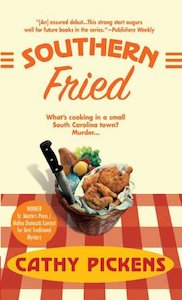
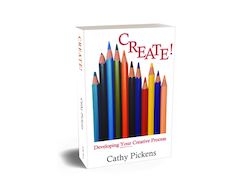

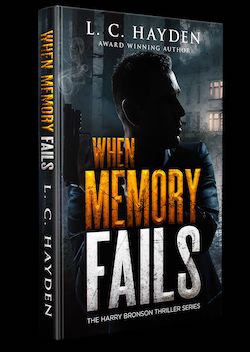
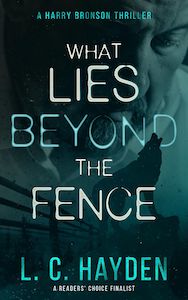
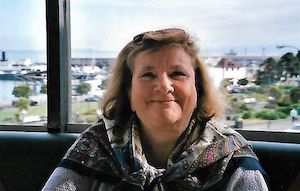
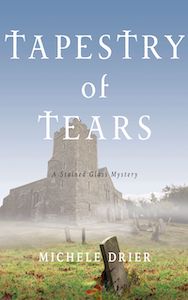
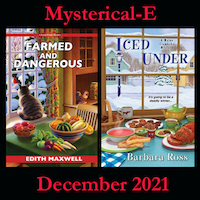
Thanks, Kaye, for a wonderful article. I loved how when working on the plot process, Cathy Pickens “loves to play with things that interest” her. I also found it fascinating how Michele Drier explained how the linear way of writing a story works for her. Overall, great interviews!
Thanks again!